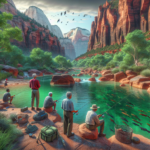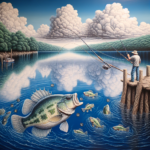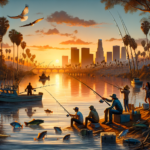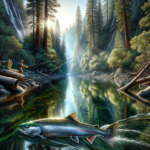Fishing in Yellowstone National Park: Rivers, Lakes, and Streams
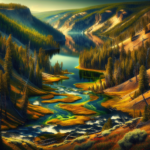
Introduction
Imagine casting your line into the pristine waters of Yellowstone National Park, surrounded by breathtaking landscapes and abundant wildlife. Did you know that Yellowstone is home to over 1,000 miles of streams and more than 200 lakes, making it a premier destination for anglers? This article will guide you through the ins and outs of fishing in Yellowstone National Park, covering everything from the best fishing spots and techniques to species information and seasonal considerations.
Whether you’re a seasoned angler or a novice looking to experience the thrill of fishing in one of America’s most iconic national parks, this guide will provide you with all the information you need to make the most of your fishing adventure in Yellowstone.
Background/Context
Historical or Cultural Significance
Yellowstone National Park, established in 1872, is not only the first national park in the United States but also the first in the world. The park’s rich history includes a long tradition of fishing, dating back to the Native American tribes who fished these waters for sustenance. Over the years, fishing in Yellowstone has evolved into a popular recreational activity, attracting anglers from around the globe.
Geographical Overview
Located primarily in Wyoming, with parts extending into Montana and Idaho, Yellowstone National Park spans over 2.2 million acres. The park’s diverse landscape includes geothermal features, lush forests, and expansive meadows, all contributing to a unique and thriving ecosystem. The climate varies significantly with elevation, ranging from harsh winters to mild summers, affecting the fishing conditions throughout the year.
Key Points/Details
Fishing Techniques
Technique Overview
Fly fishing is the most popular technique in Yellowstone, given the park’s abundance of trout-filled rivers and streams. Spin fishing and bait fishing are also common, especially in the park’s lakes.
When and Where to Use
Fly fishing is best suited for the park’s rivers and streams, such as the Madison, Firehole, and Yellowstone Rivers. Spin fishing and bait fishing are more effective in the park’s lakes, including Yellowstone Lake and Lewis Lake. The best time for fishing varies by location and species, but generally, late spring through early fall offers optimal conditions.
Recommended Gear
- Fly Fishing: 4-6 weight rods, floating lines, and a variety of dry flies, nymphs, and streamers.
- Spin Fishing: Medium-light to medium rods, spinning reels, and lures such as spinners, spoons, and soft plastics.
- Bait Fishing: Light to medium rods, spinning or baitcasting reels, and live bait such as worms or artificial baits like PowerBait.
Species Information
Species Overview
Yellowstone is home to several fish species, with trout being the most sought-after. Key species include:
- Yellowstone Cutthroat Trout: Native to the park, found in rivers and lakes.
- Rainbow Trout: Common in rivers and streams, known for their acrobatic fights.
- Brown Trout: Often found in deeper waters, particularly in the Madison and Firehole Rivers.
- Brook Trout: Typically found in smaller streams and high-elevation lakes.
- Lake Trout: Predominantly in Yellowstone Lake, known for their size and strength.
Best Practices
To successfully catch these species, consider the following tips:
- Yellowstone Cutthroat Trout: Use dry flies and nymphs in rivers and streams, and small spinners in lakes.
- Rainbow Trout: Opt for dry flies, nymphs, and streamers in rivers, and spoons or spinners in lakes.
- Brown Trout: Streamers and nymphs work well in deeper waters, especially during early morning or late evening.
- Brook Trout: Small dry flies and nymphs are effective in streams and high-elevation lakes.
- Lake Trout: Use large spoons, jigs, or live bait in deeper sections of Yellowstone Lake.
Location Information
Top Fishing Spots
- Yellowstone River: Known for its large cutthroat trout, accessible from various points within the park.
- Madison River: Famous for its brown and rainbow trout, with easy access from the West Entrance.
- Firehole River: Unique due to its geothermal features, offering excellent fly fishing opportunities.
- Yellowstone Lake: The largest high-elevation lake in North America, home to lake trout and cutthroat trout.
- Lewis Lake: Offers good fishing for lake trout and brown trout, with boat access available.
Regulations and Licenses
Fishing in Yellowstone requires a special permit, which can be purchased at various locations within the park or online. Anglers must adhere to specific regulations, including catch-and-release policies for certain species, gear restrictions, and seasonal closures. Always check the latest regulations before fishing.
Seasonal Considerations
Seasonal Variations
Fishing conditions in Yellowstone change with the seasons:
- Spring: Rivers and streams are often high and muddy due to snowmelt, but lakes can offer good fishing as they thaw.
- Summer: Prime fishing season, with lower water levels and active fish. Be prepared for crowds.
- Fall: Cooler temperatures and fewer visitors make for excellent fishing, especially for brown trout during their spawning run.
- Winter: Limited fishing opportunities due to ice and snow, but some areas remain accessible for hardy anglers.
Best Times to Fish
The best times to fish in Yellowstone are early morning and late evening, when fish are most active. Midday can also be productive, especially in shaded areas or deeper waters.
Events and Tournaments
Event Overview
Yellowstone hosts several fishing events and tournaments throughout the year, including the annual Yellowstone Cutthroat Trout Festival and various fly fishing competitions. These events offer opportunities to learn from experienced anglers, participate in workshops, and compete for prizes.
Preparation Tips
To prepare for a fishing event or tournament in Yellowstone:
- Research the event rules and regulations.
- Practice your fishing techniques and familiarize yourself with the local waters.
- Ensure you have the appropriate gear and permits.
- Arrive early to secure a good fishing spot and acclimate to the conditions.
Tips and Best Practices
General Tips
- Always check the latest fishing regulations and obtain the necessary permits.
- Practice catch-and-release to help preserve the park’s fish populations.
- Be mindful of wildlife and maintain a safe distance from animals.
- Pack out all trash and leave no trace to protect the park’s natural beauty.
Avoid Common Mistakes
- Not checking the weather forecast: Weather can change rapidly in Yellowstone, so always be prepared.
- Using the wrong gear: Ensure you have the appropriate gear for the species and conditions.
- Ignoring local advice: Talk to park rangers and local anglers for tips and insights.
Advanced Techniques
- Mastering the double haul cast for longer fly fishing casts.
- Using strike indicators to detect subtle bites when nymph fishing.
- Employing stealth tactics, such as wearing natural-colored clothing and minimizing noise, to avoid spooking fish.
Gear and Equipment Recommendations
Essential Gear
- Fishing rod and reel appropriate for your chosen technique.
- Fishing line, leaders, and tippets.
- A variety of flies, lures, or bait.
- Waders and wading boots for river and stream fishing.
- A fishing vest or pack to carry your gear.
Optional Gear/Upgrades
- Polarized sunglasses to reduce glare and spot fish more easily.
- A landing net to safely handle and release fish.
- A waterproof camera to capture your fishing memories.
- A portable fish finder for lake fishing.
Where to Buy or Rent
Fishing gear can be purchased or rented at various locations within and near Yellowstone National Park, including park visitor centers, local outfitters, and online retailers.
Safety and Conservation
Safety Tips
- Always let someone know your fishing plans and expected return time.
- Carry a map, compass, and GPS device to avoid getting lost.
- Be aware of wildlife, including bears and bison, and know how to react if you encounter them.
- Stay hydrated and protect yourself from the sun with sunscreen and appropriate clothing.
Conservation Practices
- Practice catch-and-release to help maintain healthy fish populations.
- Use barbless hooks to minimize injury to fish.
- Respect all fishing regulations and seasonal closures.
- Avoid disturbing spawning fish and their habitats.
Planning Your Trip
Accommodations
Yellowstone offers a range of accommodations, from campgrounds and RV parks to lodges and hotels. Popular options include the Old Faithful Inn, Lake Lodge Cabins, and various campgrounds throughout the park.
Travel Tips
- Yellowstone is accessible by car from several entrances, with the West Entrance being the most popular for anglers.
- Consider visiting during the shoulder seasons (spring and fall) to avoid peak crowds.
- Plan your route and check for any road closures or construction updates.
Additional Activities
In addition to fishing, Yellowstone offers a wealth of activities, including hiking, wildlife watching, geyser gazing, and photography. Make the most of your trip by exploring the park’s diverse attractions.
Frequently Asked Questions (FAQs)
Do I need a special permit to fish in Yellowstone?
Yes, a Yellowstone National Park fishing permit is required. You can purchase it at various locations within the park or online.
What are the best times of year to fish in Yellowstone?
The best times to fish are late spring through early fall, with early morning and late evening being the most productive times of day.
Can I keep the fish I catch in Yellowstone?
Some species have catch-and-release requirements, while others have specific limits. Always check the latest regulations before fishing.
Are there guided fishing tours available in Yellowstone?
Yes, several outfitters offer guided fishing tours in Yellowstone, providing local expertise and equipment.
Conclusion
Fishing in Yellowstone National Park offers a unique and rewarding experience, surrounded by stunning natural beauty and diverse wildlife. By following the tips and guidelines provided in this article, you’ll be well-prepared to make the most of your fishing adventure. Whether you’re targeting the park’s famous trout or exploring its many rivers, lakes, and streams, Yellowstone promises an unforgettable angling experience. So grab your gear, secure your permit, and get ready to cast your line into the waters of one of America’s most iconic national parks.

